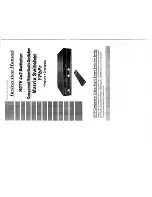
C
HAPTER
11
| Class of Service
Layer 2 Queue Settings
– 225 –
Figure 112: Setting the Queue Mode
(Strict and WRR)
M
APPING
C
O
S V
ALUES
TO
E
GRESS
Q
UEUES
Use the Traffic > Priority > PHB to Queue page to specify the hardware
output queues to use based on the internal per-hop behavior value. (For
more information on exact manner in which the ingress priority tags are
mapped to egress queues for internal processing, see
"Mapping CoS
Priorities to Internal DSCP Values" on page 232
).
The switch processes Class of Service (CoS) priority tagged traffic by using
four priority queues for each port, with service schedules based on strict
priority, Shaped Deficit Weighted Round-Robin (SDWRR), or a combination
of strict and weighted queuing. Up to eight separate traffic priorities are
defined in IEEE 802.1p. Default priority levels are assigned according to
recommendations in the IEEE 802.1p standard as shown in
Table 12
. The
following table indicates the default mapping of internal per-hop behavior
to the hardware queues. The actual mapping may differ if the CoS priorities
to internal DSCP values have been modified (
page 232
).
The priority levels recommended in the IEEE 802.1p standard for various
network applications are shown in
Table 13
. However, priority levels can be
mapped to the switch’s output queues in any way that benefits application
traffic for the network.
Table 12: IEEE 802.1p Egress Queue Priority Mapping
Priority
0
1
2
3
4
5
6
7
Queue
1
0
0
1
2
2
3
3
Table 13: CoS Priority Levels
Priority Level
Traffic Type
1
Background
2
(Spare)
0 (default)
Best Effort
3
Excellent Effort
4
Controlled Load
5
Video, less than 100 milliseconds latency and jitter
Summary of Contents for ES3510MA
Page 1: ...Management Guide www edge core com 8 Port Layer 2 Fast Ethernet Switch...
Page 4: ...ABOUT THIS GUIDE 4...
Page 30: ...CONTENTS 30...
Page 40: ...FIGURES 40...
Page 46: ...TABLES 46...
Page 48: ...SECTION I Getting Started 48...
Page 72: ...SECTION II Web Configuration 72...
Page 88: ...CHAPTER 3 Using the Web Interface Navigating the Web Browser Interface 88...
Page 116: ...CHAPTER 4 Basic Management Tasks Resetting the System 116...
Page 154: ...CHAPTER 5 Interface Configuration VLAN Trunking 154...
Page 216: ...CHAPTER 8 Spanning Tree Algorithm Configuring Interface Settings for MSTP 216...
Page 350: ...CHAPTER 14 Security Measures DHCP Snooping 350...
Page 440: ...CHAPTER 17 IP Services Displaying the DNS Cache 440...
Page 484: ...CHAPTER 19 Using the Command Line Interface CLI Command Groups 484...
Page 554: ...CHAPTER 21 System Management Commands Switch Clustering 554...
Page 574: ...CHAPTER 22 SNMP Commands 574...
Page 582: ...CHAPTER 23 Remote Monitoring Commands 582...
Page 636: ...CHAPTER 24 Authentication Commands Management IP Filter 636...
Page 736: ...CHAPTER 29 Port Mirroring Commands RSPAN Mirroring Commands 736...
Page 816: ...CHAPTER 34 VLAN Commands Configuring Voice VLANs 816...
Page 830: ...CHAPTER 35 Class of Service Commands Priority Commands Layer 3 and 4 830...
Page 848: ...CHAPTER 36 Quality of Service Commands 848...
Page 900: ...CHAPTER 38 LLDP Commands 900...
Page 910: ...CHAPTER 39 Domain Name Service Commands 910...
Page 916: ...CHAPTER 40 DHCP Commands DHCP Client 916...
Page 948: ...CHAPTER 41 IP Interface Commands IPv6 Interface 948...
Page 950: ...SECTION IV Appendices 950...
Page 982: ...INDEX 982...
Page 983: ......
















































